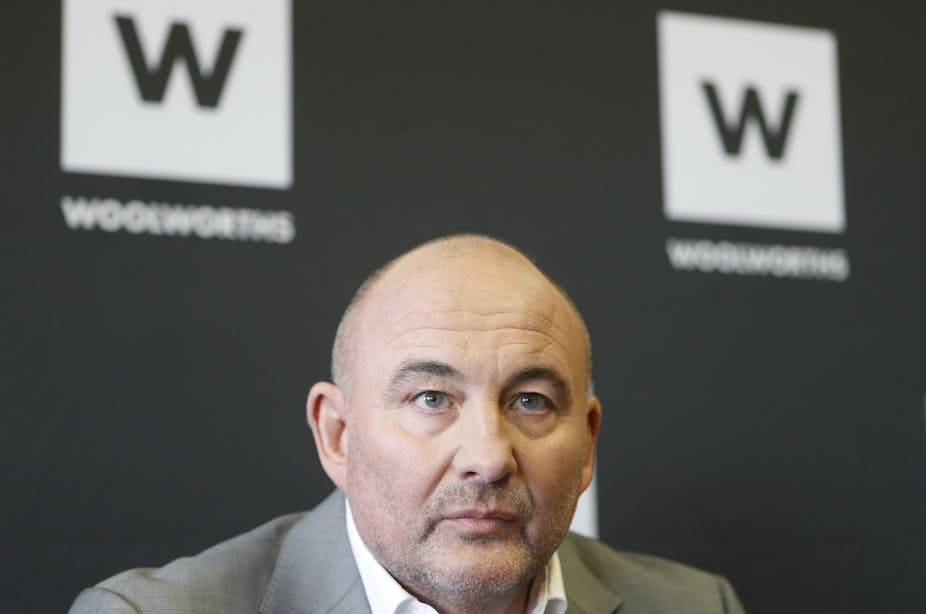Yesterday morning came the news South African retailer Woolworths had offered $4 a share to acquire David Jones, a proposal that has the approval of the department store’s board. This offer, worth an estimated A$2.15 billion, represents a 25% premium over the current share price value. An earlier offer, from rival Myer, was rejected earlier this year.
But who is Woolworths? Not to be confused with Australia’s largest supermarket, Woolworths SA is one of South Africa’s largest retailers.
No ordinary grocer
Woolworths SA has been one of the biggest South African retailers since the early 1930s, primarily targeting middle-class and wealthy consumers. The company’s first foray into department stores came after World War 2, when it established strategic links with British retailer Marks & Spencer and modelled their stores on the British retailer’s layout and design. Although a close relationship still exists between them, neither has vested financial interests in the other today.
Woolworths SA operates a number of different retail offerings – from full-line homeware stores to food and groceries – in South Africa, neighbouring countries, as well as in Australia and New Zealand. from full-line homeware stores to food and groceries.
The chain currently offers only a small range of products through its recently launched online platform. But it has moved into a number of different online spaces quickly. Woolworths partnered with one of South Africa’s largest marketing agencies Quirk, for instance, to develop a f-commerce (Facebook-commerce) platform, targeting South Africa’s fast growing younger tech-savvy consumer.

In all, Woolworths SA operates 150 corporate-owned stores and nearly 70 franchises in South Africa. It also has over 50 international franchises in other African nations and the Middle East.
Woolworths is not foreign to Australia either, owning nearly 90% of retail chains Country Road, Witchery and Trenery since 1998.
Nor is Woolworths CEO Ian Moir a stranger to Australia’s sometimes colourful world of business identities, being involved in a spat with businessman Solomon Lew over Country Road for nearly two decades. Lew is Country Road’s second largest shareholder through his company Australian Retail Investments, which lost a bidding war with Woolworths for control of the retailer.
A strong suitor
The arrival in South Africa of global powerhouses like Zara, Topshop and soon H&M, (which also launched in Australia this week) has forced Woolworths to innovate. Since then, it has been working on a procurement strategy to shorten lead times, and claims it can now get more than 30% of its own range to the market in just five to seven weeks, where previously it took more than 11 months.
Its financial reports suggest the company has significant cash resources, a strong retail strategy and is looking to expand. In February, the retailer announced an aggressive three-year plan to roll out Country Road, Witchery and Mimco stores into South Africa.
Overall half-year sales across the global group increased 16.2% for 2013, compared to 8% growth in clothing sales for comparable stores.
The group’s Australian subsidiary Country Road performed extremely well with net profit increasing 72% to $37.95 million for the six months to December 28, up from $22.1 million for the same period in 2012.
A happy pairing?
If the takeover is successful, David Jones will have access not only to cash, but international retail management expertise, which will allow it to improve its online offering, refurbish stores, improve its range and secure exclusive international brands.
The acquisition of David Jones will mean Woolworths can reach a sufficient scale to compete effectively with other large global retailers. The announcement referred to “efficiencies and economies of scale that will over time deliver a material improvement in profitability” as the rationale for the takeover.
A reinvigorated David Jones, clearly positioned as a high-end, full-service department store will capture a bigger slice of discerning shoppers’ dollar. Already, international fashion retailers – Hermes, Louis Vuitton and Hugo Boss, for instance – are entering or expanding in the Australian market, so it is evident that opportunities exist in this segment.
The takeover comes during a period of rapid expansion for Woolworths, as it reorientates business away from some emerging African countries – late last year it withdrew from Nigeria – and as it focuses on internationalising its existing brands.
The challenge for rival Myer is that it is currently “stuck in the middle” with no clear position.
Considerable risks
But high-end department stores in Australia are not in the same strong market position as department stores in South Africa. Wealth in South Africa has become more highly concentrated in the hands of the rich since the transition to democracy began in 1993. Between 1993 and 2008, the middle class grew 26% while the wealthiest trebled in size and grew from 0.4% of the population to 1.3%.
With South Africa’s population more than double that of Australia, Woolworths SA has continued to grow, while meeting the needs of an emerging middle and upper class.
In Australia, the high-end shopper segment is relatively small and predominantly located in cities like Melbourne, Sydney, Brisbane and growing in Perth.
And Australian shoppers continue to be cautious. Westpac’s Melbourne Institute Index of Consumer Sentiment suggests the shine may have come off retail spending already as households start to worry about the future. Specifically, the component of the Index measuring consumers’ expectations for the economy over the next 12 months is at its lowest level since March 2012.
Woolworths SA may be biting off more than it can chew.

